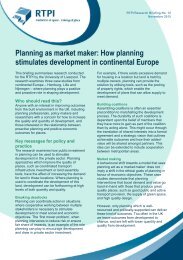estonia-2030_en
estonia-2030_en
estonia-2030_en
You also want an ePaper? Increase the reach of your titles
YUMPU automatically turns print PDFs into web optimized ePapers that Google loves.
3. During the Soviet era, rapidly growing agricultural c<strong>en</strong>tral urban communities (mainly thecurr<strong>en</strong>t small towns) became the main group of urban communities;4. As a result of long-lasting conc<strong>en</strong>tration, at this mom<strong>en</strong>t one Estonian county (Harju County) isinhabited by more than one third of Estonia’s population and produces more than one half ofEstonia’s gross national product.Mostly, however, the settlem<strong>en</strong>t system has be<strong>en</strong> rather stable: proportions of cities and towns withrespect to each other (capital – regional c<strong>en</strong>tres – county c<strong>en</strong>tres – towns) have remained nearly thesame over three-quarters of a c<strong>en</strong>tury. Status in the settlem<strong>en</strong>t hierarchy has remained unchanged,and the indicators of share within the <strong>en</strong>tire settlem<strong>en</strong>t system have moved by just a few perc<strong>en</strong>tagepoints.The overall directions in settlem<strong>en</strong>t going forward are predicted to include moderate multi-levelconc<strong>en</strong>tration in Estonia's settlem<strong>en</strong>t system and moderate dispersal within urban areas (at theexp<strong>en</strong>se of suburbanisation and the developm<strong>en</strong>t of satellite urban communities).It is the above that the spatial planning of the settlem<strong>en</strong>t system needs to consider. That said, theplanning in question is not so much one that examines the developm<strong>en</strong>t conditions for individualurban communities but rather one that addresses links betwe<strong>en</strong> (typological) settlem<strong>en</strong>t groups andregions.All in all, it may be said that Estonia’s curr<strong>en</strong>t settlem<strong>en</strong>t system attained its shape as a result of a longevolution and that for the society is neither necessary nor feasible to overhaul the existing structure.The Estonia <strong>2030</strong>+ national spatial planEstonia continues to strive for nationwide balance in the settlem<strong>en</strong>t system, above all through th<strong>en</strong>etwork of county c<strong>en</strong>tres, for towns and rural urban communities are unable to provide <strong>en</strong>oughsuffici<strong>en</strong>tly diverse jobs or services for their resid<strong>en</strong>ts whose education levels and requirem<strong>en</strong>ts withrespect to their standard of living are increasing in step with the wishes of the national populationoverall. Due to the unavoidable changes in the population, many rural urban communities and townswill be dwindling also in the near future, with the number of service facilities there possibly decreasingas well. Giv<strong>en</strong> these circumstances, the preservation of settlem<strong>en</strong>t in towns and rural areas willneed to be supported by better linkage with county c<strong>en</strong>tres and other larger cities and towns withindaily activity spaces (see subsection 3.3). In this, mainly improving the county-level organisation ofpublic transport will be of help – it will need to supplem<strong>en</strong>t and partly supersede the growing automobiletraffic. Promoting transport will be complem<strong>en</strong>ted by the provision, supported by the state, ofhigh-speed data communications connections, various e-services and remote-work facilities acrossEstonia.18




